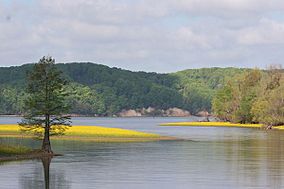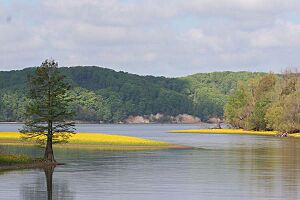Tennessee National Wildlife Refuge facts for kids
Quick facts for kids Tennessee National Wildlife Refuge |
|
|---|---|
|
IUCN Category IV (Habitat/Species Management Area)
|
|
 |
|
| Location | Benton, Decatur, Henry, Humphreys counties, Tennessee, United States |
| Nearest city | New Johnsonville, Tennessee |
| Area | 51,359 acres (207.84 km2) |
| Established | 1945 |
| Governing body | U.S. Fish and Wildlife Service |
| Website | Tennessee National Wildlife Refuge |
The Tennessee National Wildlife Refuge is a special place in West Tennessee. It's a protected area along the Tennessee River. This refuge was created in 1945 to help protect nature.
It became a great home for many water birds. This happened after Kentucky Lake was formed. The Tennessee Valley Authority built a dam, which created a large wetland area. Wetlands are like soggy lands that many animals love. The refuge covers a huge area of about 51,359 acres. That's like 39,000 football fields!
Contents
What is a National Wildlife Refuge?
A National Wildlife Refuge is a special area set aside by the United States government. Its main job is to protect wild animals and their homes. These refuges make sure that animals have safe places to live, eat, and raise their young.
The United States Fish and Wildlife Service manages all these refuges. They work hard to keep the land healthy. This helps many different kinds of plants and animals thrive.
Why Was This Refuge Created?
The Tennessee National Wildlife Refuge was started in 1945. It was created to help protect migratory birds. These are birds that fly long distances between their summer and winter homes. The new Kentucky Lake offered perfect resting and feeding spots for them.
The refuge also helps protect other wildlife. It makes sure that the natural environment stays healthy. This is important for all the creatures that call this area home.
Exploring the Refuge's Sections
The Tennessee National Wildlife Refuge is very large. It is split into three main parts. These parts stretch along the Tennessee River. Each section offers unique habitats for wildlife.
Big Sandy Unit
The Big Sandy Unit is the northernmost part of the refuge. It is located in Benton and Henry counties. This area is known for its wide-open waters and marshy areas. Many ducks and geese gather here.
Duck River Unit
Next, as you go upstream, is the Duck River Unit. This section is found in Benton and Humphreys counties. It includes parts of the Duck River. This river flows into the Tennessee River. It provides important habitats for fish and other water creatures.
Busseltown Unit
The southernmost part is the Busseltown Unit. It is located in Decatur County. This unit has a mix of forests and wetlands. It's a great place to see different types of wildlife.
Animals You Might See
The refuge is home to many amazing animals. It's especially famous for its birds. But you can also find mammals, reptiles, and amphibians here.
Birds of the Refuge
Many different birds live or visit the refuge. Waterfowl like ducks, geese, and swans are very common. They use the wetlands for food and shelter. You might see thousands of them during migration seasons.
Other birds include bald eagles, ospreys, and various songbirds. The refuge provides safe nesting spots for many species. Birdwatching is a popular activity here.
Mammals and Other Wildlife
Beyond birds, the refuge is home to many mammals. You might spot deer, raccoons, and even bobcats. Smaller animals like squirrels and rabbits are also common.
Reptiles like turtles and snakes live in the wetlands and forests. Amphibians, such as frogs and salamanders, thrive near the water. The refuge protects all these creatures.
Visiting the Refuge
The Tennessee National Wildlife Refuge is open to visitors. It's a great place to learn about nature. You can enjoy many outdoor activities here.
Fun Activities for Kids
- Birdwatching: Bring binoculars and try to spot different bird species.
- Hiking: Explore the trails and see the diverse habitats.
- Photography: Capture amazing pictures of wildlife and landscapes.
- Fishing: Some areas are open for fishing, following specific rules.
- Learning: The refuge often has educational programs. These teach about conservation and wildlife.
Remember to always respect the wildlife and their home. Stay on marked trails and do not disturb the animals.



